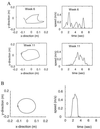Quantization of continuous arm movements in humans with brain injury
- PMID: 10200316
- PMCID: PMC16386
- DOI: 10.1073/pnas.96.8.4645
Quantization of continuous arm movements in humans with brain injury
Abstract
Segmentation of apparently continuous movement has been reported for over a century by human movement researchers, but the existence of primitive submovements has never been proved. In 20 patients recovering from a single cerebral vascular accident (stroke), we identified the apparent submovements that composed a continuous arm motion in an unloaded task. Kinematic analysis demonstrated a submovement speed profile that was invariant across patients with different brain lesions and provided experimental verification of the detailed shape of primitive submovements. The submovement shape was unaffected by its peak speed, and to test further the invariance of shape with speed, we analyzed movement behavior in a patient with myoclonus. This patient occasionally made involuntary shock-like arm movements, which occurred near the maximum capacity of the neuromuscular system, exhibited speed profiles that were comparable to those identified in stroke patients, and were also independent of speed.
Figures







Similar articles
-
The use of overlapping submovements in the control of rapid hand movements.Exp Brain Res. 2002 Jun;144(3):351-64. doi: 10.1007/s00221-002-1060-6. Epub 2002 Apr 13. Exp Brain Res. 2002. PMID: 12021817
-
Origins of submovements in movements of elderly adults.J Neuroeng Rehabil. 2008 Nov 13;5:28. doi: 10.1186/1743-0003-5-28. J Neuroeng Rehabil. 2008. PMID: 19014548 Free PMC article.
-
Influence of biomechanical factors on substructure of pointing movements.Exp Brain Res. 2005 Aug;164(4):505-16. doi: 10.1007/s00221-005-2271-4. Epub 2005 Apr 26. Exp Brain Res. 2005. PMID: 15856206
-
Effects of speeds and force fields on submovements during circular manual tracking in humans.Exp Brain Res. 2005 May;163(2):214-25. doi: 10.1007/s00221-004-2169-6. Epub 2005 Jan 25. Exp Brain Res. 2005. PMID: 15668793
-
The role of different submovement types during pointing to a target.Exp Brain Res. 2007 Jan;176(1):132-49. doi: 10.1007/s00221-006-0603-7. Epub 2006 Jul 7. Exp Brain Res. 2007. PMID: 16826410
Cited by
-
A comparative analysis of speed profile models for wrist pointing movements.IEEE Trans Neural Syst Rehabil Eng. 2013 Sep;21(5):756-66. doi: 10.1109/TNSRE.2012.2231943. Epub 2012 Dec 10. IEEE Trans Neural Syst Rehabil Eng. 2013. PMID: 23232435 Free PMC article.
-
Does dystonia always include co-contraction? A study of unconstrained reaching in children with primary and secondary dystonia.Exp Brain Res. 2007 Jan;176(2):206-16. doi: 10.1007/s00221-006-0606-4. Exp Brain Res. 2007. PMID: 16850323
-
Time-Based and Path-Based Analysis of Upper-Limb Movements during Activities of Daily Living.Sensors (Basel). 2023 Jan 23;23(3):1289. doi: 10.3390/s23031289. Sensors (Basel). 2023. PMID: 36772329 Free PMC article.
-
Robotic measurement of arm movements after stroke establishes biomarkers of motor recovery.Stroke. 2014 Jan;45(1):200-4. doi: 10.1161/STROKEAHA.113.002296. Epub 2013 Dec 12. Stroke. 2014. PMID: 24335224 Free PMC article.
-
Analyzing movement trajectories using a Markov bi-clustering method.J Comput Neurosci. 2009 Dec;27(3):543-52. doi: 10.1007/s10827-009-0168-0. Epub 2009 Jun 12. J Comput Neurosci. 2009. PMID: 19521757
References
-
- Woodworth R S. Ph.D. thesis. New York: Columbia University; 1899.
-
- Crossman E R F W, Goodeve J. Q J Exp Psychol. 1983;35:251–278. - PubMed
-
- Fitts P M. J Exp Psychol. 1954;47:381–391. - PubMed
-
- Jagacinski R J, Hartzell E J, Ward S, Bishop K. J Mot Behav. 1978;10:123–131. - PubMed
-
- Jagacinski R J, Repperger D W, Moran M S, Ward S L, Glass B. J Exp Psychol Hum Percept Perform. 1980;6:309–320.
Publication types
MeSH terms
LinkOut - more resources
Full Text Sources
Other Literature Sources

